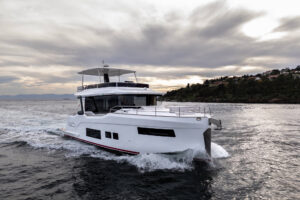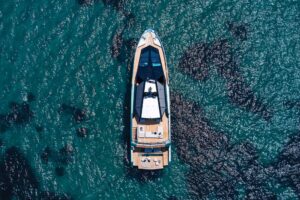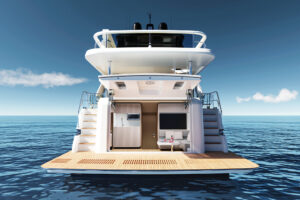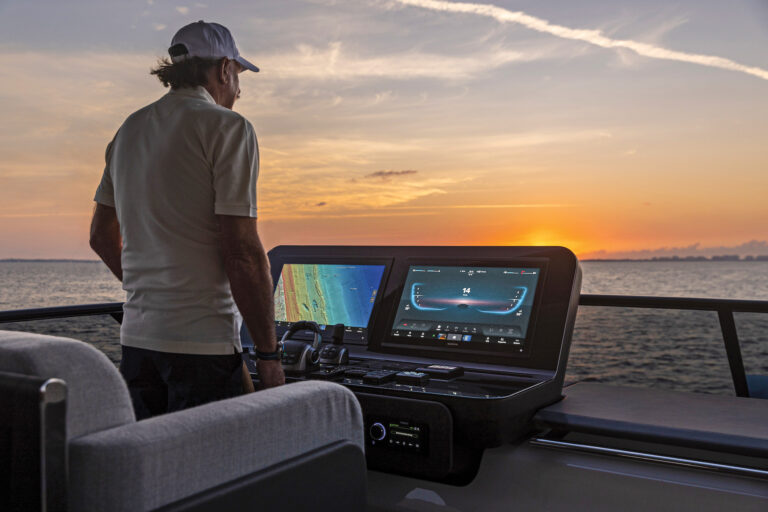Those who love fine vehicles dream of finding something extraordinary and acquiring it for a song. Depending on your taste, it might be a dusty Duesenberg in a barn, a mint Porsche Speedster under a tarp or a Stearman biplane forgotten in a hangar. For John Buettner, it was a Bertram 72.
This is a bit surprising given the 72’s dubious execution and reputation in the industry. The idea for the model began in the late 1980s, when Bertram Yacht saw the need for a mega-sportfisherman in the marketplace. The company began working toward a yacht that would have palatial accommodations yet continue in the Bertram tradition of seaworthy fishing machines. The 72 would be the first Bertram with a balsa-cored hull and bottom, and with 12-cylinder MTU diesels, she would be a small ship with complex and redundant systems. Unfortunately, the 72 was introduced in 1990-one of the worst times for Bertram and the boating market.
Bertram was self-destructing-through a series of management problems as well as a financial crisis. (Today, Bertram Yacht is on solid ground as part of the Ferretti Group.) Morale was low, and there was little money for thorough research and development for the 72 project. The entire boating industry was mired in a recession, and the final nail in the coffin was a new luxury tax.
It quickly became apparent that the supposed strength of the Bertram 72-the balsa-cored hull and bottom, was also her weakness. The balsa core was badly engineered and poorly installed, leading to serious water-saturation problems. This contributed to the decision to end production of the 72 at just five hulls.
Fast forward to 1999, as Buettner was admiring Treasure Chest, a Bertram 72 hauled in a California shipyard. Buettner is no stranger to yachting. He was and still is president of Stan Miller Yachts in Long Beach, California, and proving that he’s a longtime Bertram aficionado, he has a flawlessly restored 31-footer at his dock.
When he asked about the boat, Buettner found that she was for sale cheap, and his ears turned into pointed tufts at the thought. Moreover, the task of turning this 72 into a seaworthy yacht wasn’t especially daunting for a person with his yachting experience.
A look into her history revealed that Treasure Chest, long a fixture in the fishing grounds of Cabo San Lucas, had recently been traded to new owners in Texas, who promptly discovered that her hull was a soggy and delaminating mess. (Surveyors estimated the boat was carrying more than four tons of water in her core.) The owners had talked to a number of boatyards and builders to see about repairs, and bids had come back starting at more than a million dollars. Proposed solutions ranged from injecting the hull with resin to removing the engines and turning over the 60-ton yacht for repair.
Buettner contacted the former owners’ attorneys and offered $390,000 for the yacht. After six months of negotiations, he was told to bring a cashier’s check and pick up his boat.
Buettner, of course, had already done his due diligence and, with extensive contacts in the marine industry, had talked to Dennis Choate of Dencho Marine in Long Beach, California. Choate is a respected custom boatbuilder who relishes difficult and high-tech projects such as large ocean-racing sailboats. He had been one of the original repair bidders, but at $200,000, his estimate was so low it wasn’t even considered. That was a mistake for the Texans and a coup for Buettner.
At the same point, Buettner brought in naval architecture firm Sharp Design to look at the existing laminates and devise a new laminate schedule that would be stronger than the original.
Treasure Chest was delivered to a shipyard where Buettner had leased space. There, the yacht was cocooned in plastic from the sheer up, since the remainder of the boat was in fairly good condition but needed protection from the dust and dirt of the project.
A cut was made into the hull, and the balsa core poured out like a hearty bowl of Cream of Wheat. It was thoroughly rotted, and the outer skin of the fiberglass had delaminated. Modern cored hulls have solid fiberglass areas for through-hull fittings, but Bertram had simply drilled into the balsa, allowing water to wick through the core. Worse, the chines were left open, allowing water to move throughout the hull.
Choate had seen a television advertisement for the Roto Zip spiral saw and bought several for his crew, who used them to cut 5- to 10-foot panels out of the hull bottom and 2 feet up from the waterline. John Bradshaw, the marine surveyor who monitored the project, was impressed by Dencho Marine’s effort. “There were a lot of very skilled guys on the project, Bradshaw said. “At times, it reminded me of an army of ants tackling a grasshopper.
With the inner skin bare, it was apparent there had been some delamination, so Choate added new vinylester laminate atop the old skin to create a solid base. At the same time, the team remedied Bertram’s mistakes by installing solid fiberglass filler pieces anywhere the hull was punctured, including through-hull fittings, sea chests and the bow thruster.
With that phase complete, Dencho Marine vacuum-bagged Divinycell foam core into place to match the thickness of the original balsa, and cranking the vacuum up to 24 inches of mercury, added the outer skin. Choate’s crew is so skilled with vacuum-bagging that the hull bottom and topsides needed almost no fairing when the job was finished. Injecting nearly 500 gallons of Clark urethane foam to prevent water entry and future chine damage solved the problem of the chine void.
“I didn’t see any problem in the repair at the beginning, and it went just as I’d planned, said Choate, who works worldwide handling difficult repairs and projects such as hull extensions.
“There were smaller boats hauled out for blister jobs that took longer than the entire bottom on our 72, Buettner said. The project lasted less than four months.
With the boat refinished in Awlgrip and named Good Bud, Buettner tackled the rest of the yacht. “She was basically in good shape, and I could have left her alone, but as my friends will tell you, I’m a perfectionist, so we kept going, Buettner said.
The 1,873 hp 12V 396TB93 MTUs had just undergone a $115,000 overhaul, and the Onan gensets were in good shape, but Buettner replaced every pump and motor on Good Bud. Buettner planned to fish in Cabo, so a new CruiseAir chilled-water a/c system was installed along with an 800-gallon-per-day Sea Recovery watermaker. Since generators must be shut off at night at Catalina Island, a Buettner cruising favorite, a new bank of batteries and Trace inverter now provide ample power. The original fiberglass fuel tanks alleviated any worries about leaks, and the oversize rotary switches on the electrical panels were in fine condition.
While the 72 had “big ship systems such as Kobelt pneumatic shifting and a hydraulic bow thruster, Good Bud was fitted with a Naiad stabilizer system, a major improvement. “We spend a lot of time trolling, and this makes the 72 as solid as a rock, said Buettner.
This Bertram 72 had a three-stateroom arrangement with the galley up, and Bertram had completely enclosed the galley. Buettner ripped out the old galley and in the process created a large opening into the saloon. “Now I can stand in the galley and keep an eye on the jigs, he said. Buettner used granite for the galley counters and sole, adding Miele and Gaggenau stainless-steel appliances.
The interior had maple accents, but Buettner brought in painter Rick Rupert to refinish all the surfaces in high-gloss white. Soft goods, from the padded overhead to the leather couches, were replaced. The master head also got the marble treatment, and in general, the interior was freshened.
In the dozen years since the 72 was launched, electronics have evolved considerably. Crew West replaced every electronic component. A new dashboard was fashioned in the enclosed pilothouse so units could be flush-mounted. Other updates included entertainment systems with a pop-up, surround-sound television in the saloon and closed-circuit security cameras. The final touch was a classic Rybovich fighting chair in the cockpit.
In less than a year, Good Bud had made the transition from a hopeless yacht likely to be chainsawed for her engines to a pristine sportfisherman with classic Bertram lines.
“This was the most fun I’ve had in a long time, laughed Buettner, “and now I have this wonderful yacht, too. His grin says the experience was even better than finding a Duesenberg in a barn.
Contact: Stan Miller Yachts, (562) 598-9433; View VR tour at www.stanmiller.com.









